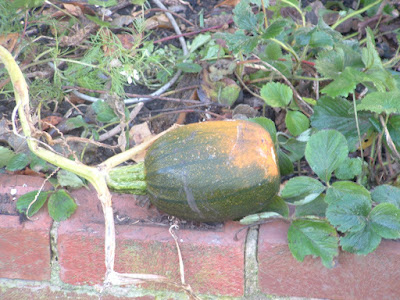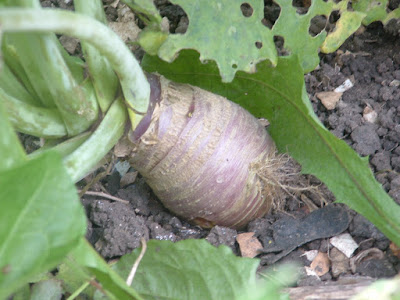 |
| Three sisters: runner beans on trellis (far left), sweet corn, squash; September 2017 |
Roots
Just celery and beets left in Roots bed, with a pot of spring onions and some carrots still in their planters. I picked a few celery stalks and beets here and there, but mainly just harvested carrots from this section in September. Green manure seeds broadcast in August still not made an appearance (should probably resow).
Peas and beans
Lots of runner beans at the beginning of the month, but slowed down by the end. Letting a few grow on for seed.
Brassicas
Caterpillars mostly gone from brassicas by the end of the month. We were still squishing a few at the beginning of the month.
Transplanted Brussels sprouts from the holding bed, to where the French beans had been. Forming some small sprouts, but leaves still pretty holey from earlier caterpillar damage. Purple sprouting broccoli growing nicely, and I staked it up.
Harvested a little bit of kale; seems to be just one plant growing now after caterpillars. Kale seedlings potted up, to hopefully be transplanted out soon.
Planted spring cabbage in cold frame; a few plants might go into next year's Brassicas bed (this year's Potatoes bed) in October. Sowed cauliflower for next summer, which has now sprouted. Pak choi in planter growing slowly--someone has been nibbling it. I'm beginning to think it's not worthwhile to grow, as it always gets munched no matter where I plant it.
Turnips still very small, and nearly all leaf--a few have very thin purple roots forming. About four rutabagas around 3-4 cm in diameter (pretty small still). The last two summer cabbages still forming (small) heads.
Miscellaneous
Harvested a few handfuls of tomatillos: tasty cooked in curry and stew.
Regular tomato plants started showing signs of blight, so picked all the green fruits, chopped them, and froze for making green salsa later. Put the plants in the council compost bin, which they collect every two weeks. One plant left, in a planter; its (sparse) fruit is beginning to go orange. Only harvested 2 ripe tomatoes in total.
Harvested more cherry tomatoes in September. A few cherry tomato
plants also look a bit diseased, but still producing ripe fruits; I've been picking off
diseased leaves/fruits. As we've already had a good amount off these, it's not a big deal if they die of blight, unlike the regular tomatoes which we still had yet to harvest.
Picked five squashes for winter storage; I left a couple yellow/immature ones on the vine to (hopefully) ripen in October. One pumpkin mostly orange, a couple other small ones growing but still green--none picked yet.
Zuccini productive until about the middle of September, then pretty much finished by the end. Four plants (out of seven) finally started producing female flowers in the last week of September. Picked them just after flowering--too late in the season to really grow, but tasty anyway.
Sweet corn ears growing fatter but none harvested yet. Plants got battered by winds, but still growing. Leeks growing slowly; about 8-10 left, after chicken damage. One chicken seemed to have a vendetta against them; she jumped the fence every day for about two weeks and scratched at them, even with wire mesh on top to protect them.
Radishes mostly finished by the end of the month. Chard slowing down, but still being harvested throughout the month. Winter lettuce very small but growing slowly. Arugula and miners and lambs lettuce seedlings sprouted in cold frame and planters (self-seeded), started picking miners lettuce at the very end of the month.
Potatoes
One bed (in the perennials section) dug up at the beginning of September; we only finished eating them by the end of the month. The other two beds (one in and the other out of the main veg bed) had stems cut off and disposed of a few weeks into September, because blight was suspected. Those tubers are still in the ground, to dig up in October.
I collected a handful of potato fruits to try planting next spring.
Fruit
About five more alpine strawberries harvested this month, and one last blueberry. Autumn raspberries forming but none ripened yet.
Harvested the rest of the plums and the last Sparta apple. Harvested four more figs. Williams pears and almonds still maturing.
Perennials and herbs
Artichokes still sturdy but not really grown much in September. New asparagus plants still alive, still little and spindly. Sorrel and rhubarb both alive but very small.
Cut back thyme, lemon balm, and rosemary; rosemary had more die-back this month and looks very sad now--hope it survives. Harvested dill seeds for culinary use, but will save some for sowing next spring. Chives, mint, and tarragon still producing. Mint, basil, parsley, dill (leaf) and summer savory produced a very small amount.












































